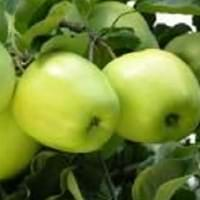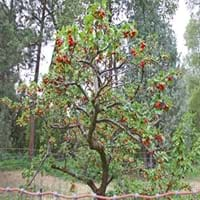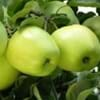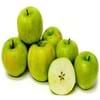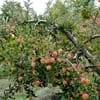Life Span
Annual
Perennial
Origin
Eastern Europe, Southern Europe, Russia/Siberia, Southern Asia, Western Asia
Hybrid origin
Types
Jonathan apple, fuji apple
Fruit
Habitat
Cold Regions, gardens
Temperate Regions
USDA Hardiness Zone
4-8
4-8
Sunset Zone
1a, 1b, 2a, 2b, 3a, 3b, 4, 5, 6, 7, 8, 9, 14, 15, 16
A2, A3, 1a, 1b, 2a, 2b, 3a, 3b, 4, 5, 6, 7, 8, 9, 14, 15, 16, 17
Habit
Oval or Rounded
Oval or Rounded
Flower Color
White, Pink
White
Flower Color Modifier
Bicolor
Bicolor
Fruit Color
Yellow, Yellow green
Red, Dark Red
Leaf Color in Spring
Green
Dark Green
Leaf Color in Summer
Green
Dark Green
Leaf Color in Fall
Green, Light Yellow, Brown
Dark Green
Leaf Color in Winter
Light Green
Light Green
Leaf Shape
Oval
Simple lobed or unlobed
Plant Season
Spring, Fall
Spring, Summer
Sunlight
Full Sun, Partial Sun, Partial shade
Full Sun, Partial Sun
Growth Rate
Medium
Medium
Type of Soil
Clay, Loam, Sand
Loam
The pH of Soil
Acidic, Neutral
Acidic, Neutral
Soil Drainage
Well drained
Well drained
Bloom Time
Early Spring, Spring
Early Spring, Spring
Tolerances
Rocky Soil, Shade areas
Drought
Where to Plant?
Ground
Ground
How to Plant?
Grafting, Seedlings, Stem Planting
Semi-hardwood and hardwood cuttings
Plant Maintenance
Medium
Medium
Watering Requirements
Do not let dry out between waterings, Never Over-water, Use Mulches to help prevent water loss during hot and windy weather
Keep ground moist, Use Mulches to help prevent water loss during hot and windy weather
In Summer
Alternate Days
Lots of watering
In Spring
Moderate
Moderate
In Winter
Less Watering
Average Water
Soil pH
Acidic, Neutral
Acidic, Neutral
Soil Type
Clay, Loam, Sand
Loam
Soil Drainage Capacity
Well drained
Well drained
Sun Exposure
Full Sun, Partial Sun, Partial shade
Full Sun, Partial Sun
Pruning
Prune central stem, Remove lateral branches
Remove damaged leaves, Remove dead branches, Remove dead leaves
Fertilizers
Apply 10-10-10 amount, fertilize in growing season, Fertilize the soil before planting
All-Purpose Liquid Fertilizer
Pests and Diseases
Bacterial Blight, Bacterial Canker, Leaf rust, Red blotch, Ring Rot, Woodpecker feeding
Birds
Plant Tolerance
Rocky Soil, Shade areas
Drought
Flower Petal Number
Single
Single, Double
Foliage Texture
Medium
Medium
Foliage Sheen
Matte
Glossy
Attracts
Bees, Butterflies, Hummingbirds, Insects
Birds
Allergy
Peripheral Edema, Vomiting
Anaphylaxis, gastro-intestinal problems, Itchiness, Skin irritation
Aesthetic Uses
Cottage Garden, Showy Purposes
Beautification, Bouquets, Informal Hedge, Landscape Designing, Showy Purposes, Wild gardens
Beauty Benefits
Acne, For treating wrinkles, Improve skin tone, Moisturizing, Stops hair loss
Not Available
Environmental Uses
Food for animals, Shadow Tree, soil stabilisation, Windbreak
Air purification
Medicinal Uses
Acne, Alzheimer’s Disease, Anemia, constipation, Gastrointestinal disorders, Hair Loss, Parkinson
anti-inflammatory, Anti-oxidant, Gout, Insomnia, Soothing and relieving pain
Part of Plant Used
Fruits
Flowers, Fruits
Other Uses
Acts as a natural source of rain water for birds and insects., Cosmetics, Used As Food
Air freshner, Beneficial species for attracting pollinators, Cake, Edible syrup, Oil is used in perfume, soaps, creams, etc., Used to make juice
Used As Indoor Plant
No
No
Used As Outdoor Plant
Yes
Yes
Garden Design
Edible, Feature Plant, Fruit / Fruit Tree
Edible, Fruit / Fruit Tree, Mixed Border
Botanical Name
MALUS domestica 'Ginger Gold'
PRUNUS cerasus
Common Name
Apple, Ginger Gold Apple, Yellow Eating Apple
Pie Cherry, Sour Cherry, Tart Cherry
In Hindi
सुनहरा सेब
Sour cherry
In German
goldener Apfel
Sauerkirsche
In French
pomme d'Or
Prunus cerasus
In Spanish
manzana dorada
Prunus cerasus
In Greek
χρυσό μήλο
Sour cherry
In Portuguese
maçã Dourada
Ginja
In Polish
złote jabłko
Wiśnia pospolita
In Latin
aureum pomum
Prunus cerasus
Phylum
Magnoliophyta
Tracheophyta
Class
Magnoliopsida
Magnoliopsida
Clade
Dicotyledonous, Rosids
Angiosperms, Eudicots, Rosids
Tribe
Not Available
Not Available
Subfamily
Not Available
Not Available
Number of Species
Not Available
Importance of Ginger Gold Apple and Sour Cherry
Want to have the most appropriate plant for your garden? You might want to know the importance of Ginger Gold Apple and Sour Cherry. Basically, these two plants vary in many aspects. Compare Ginger Gold Apple and Sour Cherry as they differ in many characteristics such as their life, care, benefits, facts, etc. Every gardener must at least have the slightest clue about the plants he wants to plant in his garden. Compare their benefits, which differ in many ways like facts and uses. The medicinal use of Ginger Gold Apple is Acne, Alzheimer’s Disease, Anemia, constipation, Gastrointestinal disorders, Hair Loss and Parkinson whereas of Sour Cherry is anti-inflammatory, Anti-oxidant, Gout, Insomnia and Soothing and relieving pain. Ginger Gold Apple has beauty benefits as follows: Acne, For treating wrinkles, Improve skin tone, Moisturizing and Stops hair loss while Sour Cherry has beauty benefits as follows: Acne, For treating wrinkles, Improve skin tone, Moisturizing and Stops hair loss.
Compare Facts of Ginger Gold Apple vs Sour Cherry
How to choose the best garden plant for your garden depending upon its facts? Here garden plant comparison will help you to solve this query. Compare the facts of Ginger Gold Apple vs Sour Cherry and know which one to choose. As garden plants have benefits and other uses, allergy is also a major drawback of plants for some people. Allergic reactions of Ginger Gold Apple are Peripheral Edema and Vomiting whereas of Sour Cherry have Anaphylaxis, gastro-intestinal problems, Itchiness and Skin irritation respectively. Having a fruit bearing plant in your garden can be a plus point of your garden. Ginger Gold Apple has showy fruits and Sour Cherry has showy fruits. Also Ginger Gold Apple is not flowering and Sour Cherry is not flowering . You can compare Ginger Gold Apple and Sour Cherry facts and facts of other plants too.
